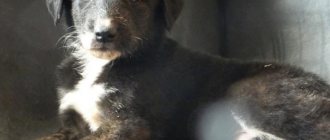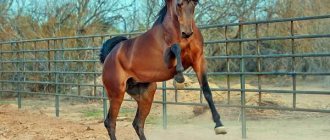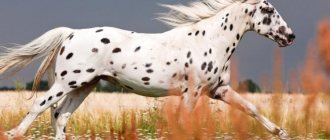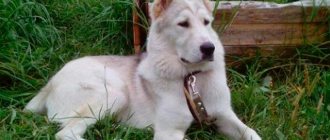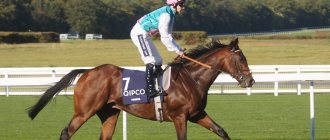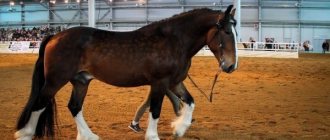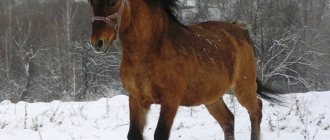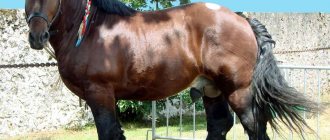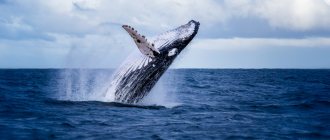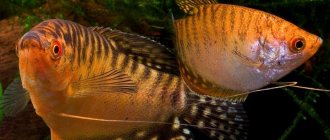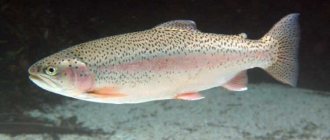Description
A characteristic feature of ponies is their low stature (80-140 cm), strong neck, short limbs and endurance. Externally, a pony looks exactly like a horse, only it is a miniature copy of it. In Russia, this concept includes horses with a height of 100-110 cm, in Germany - up to 120 cm, in Great Britain - up to 147.3 cm.
The smallest horse in the world
The smallest horse in the world is a representative of the Pinto breed named Einstein. At birth, the foal weighed only 2.7 kg and was 36 centimeters tall. Now the weight of the miniature horse is already 28 kilograms. However, Einstein is not the only contender for the title of record holder. His main competitors are the horse Tumbelina, born in 2001 with a weight of 4 kg (now her weight is 26 kilograms) and the miniature pony Bella, born with a weight of 4 kg and a height of 38 cm in a special Center for breeding miniature horses.
Nutritional Features
— Advertising —
Pony food
Ponies have a small stomach, so frequent meals in small portions are suitable for them. At the same time, there must be plenty of clean water, and the feeders must be cleanly washed. If animals spend all their time on grass, then it will become the basis of their diet, since it is absorbed by the pony’s body very easily.
Diet
But so that the food is not monotonous and the horse does not get bored, something is periodically added to it. Thus, carrots and apples have a beneficial effect on pony digestion, sugar beets contain various useful energy-intensive substances, and alfalfa, barley, ground sunflower, rapeseed with vitamins, bran and soybeans will become a source of fiber.
Pony diet
Power volume
— Advertising —
It is determined by physical activity, place of detention, living conditions and time of year. In the summer, the pony should not overeat, and in the winter and early spring, in addition to high-quality hay, he will additionally need concentrated food and vitamins.
Pony nutrition volume
Hinny
A mixture of a donkey and a domesticated horse, the domesticated species is called a hinny. There are few representatives of this hybrid branch, since they are small in size and inferior in strength and endurance to mules and ordinary horses. The maximum known height at the withers of hinnies reaches 152 cm, in 90% of cases – 110-130 cm. There are also descriptions of very small animals, whose height at the withers will be slightly higher than 60 cm.
Interesting! Externally, hinnies resemble wild horses. They have a large head and a massive neck, while their mane is short and their ears are long.
It is known that the genetic set possessed by a hybrid of a horse and a donkey (hinny) contains 63 chromosomes. Since there is an odd number of chromosome pairs, hybrids have problems with further fertilization, and the likelihood of sterility and mortality of the offspring during the period of embryonic development of the fetus increases.
It is also known that hybrid stallions are always sterile, but females are capable of procreation, but such cases are practically never recorded. Successful breeding occurred 38 years ago in China. The main reason for the low prevalence of hinnies is considered to be the mating ritual of donkeys (females rarely allow males to approach them). Poor fertility is also noted (14% of fertilizations from all cases will be successful). The gestation period lasts 350 days. Adult hinnies do not have strength and endurance, and therefore show low suitability for heavy work.
Hinny
Spreading
Ponies first appeared on islands in Europe, in the north of Scandinavia and the south of France. Sturdy, stunted, shaggy, unpretentious horses formed on rocky islands, where humid Atlantic winds blow and vegetation for grazing is poor. It was in the south of France that the remains of the oldest Solutre horses, the ancestors of modern ponies, were discovered.
South of France
Zou (cow + wild yak)
They are highly prized in Tibet and Mongolia for their meat and the amount of milk they are capable of producing. The animal is larger and stronger than a cow and a yak individually. However, it is believed that now in the regions where they live, the purity of the cow and yak genotypes has been lost.
Common types
Currently, about 20 breeds of ponies have been bred, among which there are riding and light-drawn breeds.
Shetland pony
A frisky little horse that originated on the Shetland Islands in the Atlantic Ocean. The height at the withers is 65-110 cm. This miniature draft horse has short thick legs, a heavy head, a wide body, thick hair and a long lush mane with a tail. The Shetland is very popular as a children's riding pony. It is also used in equestrian sports.
Shetland pony
The suit is varied, the most common is piebald, when large white spots are located on the main background of any color, as well as black and light gray suits.
Scottish pony
The Scottish or Highland pony or garron is divided into three types: the small pony (height 122-132 cm), the Scottish riding pony (132-140 cm), and the largest Mayland pony (142-147 cm).
Scottish pony
Welsh pony
The Welsh pony was known even under Julius Caesar. There are the Welsh mountain pony, whose height does not exceed 122 cm, the medium pony (110-136 cm) and the Welsh cob for equestrian polo (137-159 cm).
Welsh pony
Exmoor pony
This species is also known as the Celtic Pony, and is a semi-wild, ancient draft breed of small horse with a height of 114 to 125 cm. It was bred in Exmoor and Devon. It is characterized by a bay and brown color with lightening near the nostrils, the so-called “muzzle in oatmeal.”
Exmoor pony
Icelandic pony
This is a versatile pure breed, with a maximum height of 137 cm and a minimum height of 100 cm and below. Icelandic ponies are black and bay, and occasionally dun (yellowish-golden or sandy) or mousey (ash color).
Icelandic pony
Pony class
This is a group of riding ponies that have been improved by Arabian and thoroughbred riding stallions. The height is up to 147 cm and above, all kinds of colors. These ponies are strong and strong, suitable for equestrian polo and show jumping, eventing, and vaulting.
Pony class
Crossbreeds with zebras
Hybrids of zebras and other equines are commonly called zebroids. Typically, zebra stallions and mares, female ponies or donkeys are used to produce crossbreeds. Zebras are rarely mated to stallions of other species—successful fertilizations are rare. In terms of body type, zebroids are closer to their mothers, but their entire body is covered with stripes. Hybrids are used for heavy work in mountainous and desert areas, where they are seriously superior to horses.
Types of zebroids
Zebroid is the universal name for any crossbreed. As a result of such crosses, some mixing of phenotypes and dwarfism is observed. In addition to origin, most crossbreeds are united by infertility. Types found:
- zorses (Zorse) are obtained as a result of mating a mare with a male zebra, cannot leave offspring;
- hebra (Hebra, zebrini) is a sterile offspring from a stallion and a female zebra;
- Zony is a cross between a male zebra and a pony. This name is most often given to animals of medium or large size, and if Shetland ponies were taken for mating, then the hybrid is called a Zetland;
- Zebras (Zonkey) are the offspring of a zebra and a donkey. This is the only type found in the wild, as both species live side by side in South Africa. These hybrids are also unable to produce offspring.
Features of genetics and phenotype
Horses, donkeys and zebras and other equidae have different numbers of chromosomes. Thus, a donkey has 31 pairs, a zebra has 16-23 pairs, and a domestic horse has 32. Despite the differences, the formation of viable hybrids is possible, provided that the resulting combination of genes ensures normal embryonic development.
According to Haldane's rule, the homogametic type, that is, females, has greater viability and the ability to leave offspring. In reality, the resulting male hybrids are always sterile, but the females do not always have the opportunity to leave offspring, in addition, the resulting crossbreeds again have a different chromosome set from the partner, which again complicates the work.
The resulting crossbreeds are striped, but other phenotypic traits are much closer to the second partner. Stripes in hybrids cover individual parts of the body; complete “zebroid” is much less common. If piebald animals were selected for mating, then a significant part of the horse’s pattern is preserved, and the stripes appear only in areas with pigmentation. This is explained by the inheritance of a dominant depigmentation gene, so it is not worth using white horses for crossing - their offspring will be completely devoid of stripes. Zebra cats have stripes of black fur along their entire spine.
Features of the genetic structure make most horse hybrids infertile - isolated cases of fertilization of crossbred females are known.
They began to produce hybrids, since zebras are not suitable for riding or harness work - from numerous experiments, an insignificant number of successful domestication results were obtained, and the animals remained wayward. Truth and Zorses show aggressiveness and unbridled temperament in comparison with domestic animals. One of the main advantages of hybrids is that they, like zebras, are resistant to sleeping sickness, unlike other horses.
In culture and history
The first successful crossbreeding was the mating of a bay Arabian mare with a zebra male in 1815. As a result of Lord Morton's experiment, a female was obtained that resembled both parents. The features of the first hybrid were described by Charles Darwin; according to him, there were more stripes on the limbs than on a zebra. He also described zebra-pony hybrids bred by the geneticist Ewart.
During the Boer War, zebra-pony hybrids were obtained by Dutch settlers to provide troops with normal supplies and tow guns. One of the individuals was captured by English troops and delivered to King Edward for demonstration.
In the 70s of the 20th century, interest in hybrids increased against the background of the popularization of genetics and large-scale breakthroughs in science. In the English Colchester Zoo, a prototype zebra dog is obtained, and in subsequent years the work is systematized and hybrids adapted for riding are obtained. But under public pressure, the experiment was stopped, and the last of the bred crosses died in 2009.
The appearance of hybrids in works of art:
- movie "Groundhog Day";
- movie "Crazy Races";
- George R.R. Martin's A Song of Ice and Fire series of novels;
- video game "Red Dead Redemption".
There is only one zebroid in Russia, born in 2012 to a Moscow circus troupe. Zanzibar (as the hybrid is called) is the result of mating a zebra with a stallion. Use in circus performances is the most common work for such animals. But in some African countries, zebroids are used to transport goods - on a route popular among tourists in the Kenyan mountains, these hybrids are used.
Behavior
Ponies are descendants of wild subspecies of primitive horses. These cute horses were formed in the harsh climate of northern Scandinavia on rocky islands, poor in vegetation and food, which are penetrated through by cold Atlantic winds. That is why these shaggy-haired horse breeds are unpretentious, small, patient and hardy. Over time, ponies spread across many territories.
Pony behavior
Pony use
It is generally accepted that ponies are only suitable for children's entertainment. They can often be found in a park or zoo, at an equestrian school and at rentals. But in ancient times, these stocky, strong animals were kept and used for work and transporting heavy loads. These patient animals lived in the mines, without light, in coal dust and soot, and worked hard along with people.
Pony use
Pony in sports
Ponies also participate in sports competitions, racing, jumping, overcoming obstacles and other types of equestrian sports.
Pony in sports
The most beautiful breeds of mini horses
Connemara ponies are among the top most beautiful horse breeds on the planet. They first appeared in Ireland , after which they quickly spread throughout the world. These are cute-looking horses with a proportional build, thin and short legs.
Connemara horses have a gorgeous mane and tail - they are very shiny, long and thick. Most often, such horses have a dun or gray color, with small splashes of white. By nature, the animals are obedient and quite good-natured. They are unpretentious eaters and easy to train.
Since ponies, like ordinary horses, are distributed throughout the world, these miracle horses live wherever people live.
Incredible stories are told about ponies. These little girls take part in sports competitions, jumping, racing and overcoming obstacles, winning awards and valuable prizes. For example, there is a known case when the pony Scampi, at the age of 37, received first place in dressage at the Aintree sports center (Great Britain).
Reproduction
Reproduction of ponies today is a selection process. Horses are selected for mating, taking into account certain parameters that need to be obtained in the desired breed. The female's estrus lasts several days, when she mates with the male. Stallions are attracted to the specific scents of females. Males court their darlings, initiate mating games, persistently attract their attention, gently tickle the sides and shoulders of their girlfriends with their teeth, and also sniff them.
Pony breeding
Length of pregnancy
The duration of pregnancy is about 11 months.
Offspring
The female gives birth to one or two sighted babies, who within a few minutes stand on their feet and make their first attempts to walk.
Pony offspring
Lifespan
Ponies live longer than horses, 40-45 years, depending on living conditions, care and maintenance.
Pony lifespan
Mules
These hybrids are created by mating mares with donkeys. They are distinguished by their large size (not inferior to horses and seriously superior to hinnies), strength and endurance. Due to their high performance characteristics, these animals are still actively used in various sectors of the national economy. They are easy to obtain, require little care and feeding, and can cope with the heaviest loads, which is why their population in the United States alone exceeded 5 million in the mid-20th century. Males are infertile, but many cases of successful offspring are known from females.
Animal Features
The average weight of mules is 370-460 kg, but the weight has a strong dependence on the mares used for crossing, for example, hybrids with heavy draft breeds have a weight of over 500-600 kg. An important advantage of a mule is its endurance - it can carry more than 30% of its weight without a long rest. In terms of power load, a mule is significantly superior to a horse of the same size, but inferior to them in speed and other characteristics.
The exterior of the hybrid shows mixed data from both the donkey and the horse:
- big head;
- long ears;
- thin limbs;
- hooves are small, narrow in diameter;
- trimmed mane;
- the neck is massive, of medium length;
- the torso is proportional;
- sacrum drooping;
- good muscle development.
The maternal line plays a significant role in appearance - the color, size, and build depend on the breed used. The most common colors are bay, gray and black; mules with white or roan coats are much less common. Hybrids from spotted mares are very popular - mules inherit the piebald color.
History of the hybrid
For a long time, the main place where mules were used was the army - the hardy animals were ideal for enduring all the hardships of military service. Most often they were used as transport; there are known cases of small-caliber guns being installed on mules. One of the latest facts of the massive use of mules for military purposes is the Soviet-Afghan war. During this conflict, America supplied a large number of hybrids to Afghan terrorists.
Mules also found their use for civilian purposes. It is known to use teams of 18 hybrids and a pair of horses to transport nine-ton wagons loaded with borax. Mules played a significant role in the exploration of America. Unpretentious animals could carry a wagon for a long time on meager food and water shortages. And today the active use of mules continues in remote areas where there is no developed road infrastructure. Mules provide great assistance when conquering mountain peaks or building in hard-to-reach places.
In 2003, it became known about the successful experiment of cloning a mule by researchers at the University of Idaho and Utah. Born on May 4th, the foal is the only successful hybrid cloned animal. Tests and examinations by veterinarians confirmed the normal development and condition of the newborn.
Interesting facts about ponies:
- Nowadays there is a widespread belief that ponies are only for children. But before they were always used in work. For example, the Shetland pony is very strong, despite its miniature size. It is capable of carrying a load twenty times its own weight. These ponies worked in the mines and coal mines. One little horse dragged heavily loaded trolleys for 3,000 hours a year, and during this time it moved about 3,000 tons, covering approximately 5,000 km.
- Two ponies became participants in the Olympic Games: Little Model - in dressage competitions (Olympiad 1960 in Rome), and Stroller (Mexico City, 1968). The latter even received a silver medal for jumping.
Blob fish
We have all seen fish more than once and know very well what they are. They are scaled, water-dwelling, cold-blooded animals that swim using fins and a tail and breathe through gills. But in the amazingly beautiful underwater ocean world there are original specimens that can hardly be called fish, but nevertheless, they are so.
One of these species includes the drop fish, which lives in the deep waters of the Pacific, Indian and Atlantic oceans. In Latin it is called Psychrolutes marcidus, and in English it has the funny name Blobfish.
This truly strange creature does not have any external signs by which it could be classified as a fish. It completely lacks scales and has some faint semblance of fins. The body of the drop fish does not exceed 70 cm and is an incomprehensible gelatinous mass (up to 9.5 kg) with large sad eyes, a mouth and a human nose.
The blob fish lives so deep underwater where other living things cannot live. But thanks to the density of her body, somewhat less than the thickness of the water, she feels great there. The air bubble present in the fish produces the same gelatinous gel from which it consists entirely. Without it, it would be difficult for her to withstand the thickness of the water and swim. And it’s difficult to call her awkward movements that she makes as swimming, because she doesn’t have any muscles.
The drop fish feeds on plankton, which is abundant in its habitats. She opens her mouth slowly and the food floats in there on its own. People have virtually no chance to admire this sad creature of nature with their own eyes due to its deep-sea habitat. However, sometimes strong waves wash the blob fish ashore, and in some East Asian countries it is considered a delicacy. The difficulty in obtaining information does not allow us to talk much about this amazing fish.
But more recently, scientists have established one interesting fact. It was possible to find out that drop fish are the most caring parents of all existing fish species. They surround their young with touching care, hiding them in the most secluded corners of the underwater kingdom and never leaving them alone until they grow up. Despite such a strange appearance, scientists were able to classify the drop fish to the class of bony fish, the order of ray-finned fish, and the suborder of scorpionfish.
Hybridization
| Dog | Wolf | Dingo | Coyote | Common jackal | Striped jackal | Black-backed jackal | Red Wolf | Red fox |
| Dog | wolf dogs | coydog | Sulimov's dog | X | ||||
| Wolf | wolf dogs | coywolf | x | |||||
| Dingo | x | |||||||
| Coyote | coydog | coywolf | x | |||||
| Common jackal | Sulimov's dog | x | ||||||
| Striped jackal | x | |||||||
| Black-backed jackal | x | |||||||
| Red Wolf | x | |||||||
| Red fox | X | x | x | x | x | x | x | x |
Domestic fox: good-natured like a dog and independent like a cat
The idea of domesticating a fox first came to the mind of Soviet geneticist Dmirty Belyaev in the 1950s. Taking the population of silver-black foxes as a basis, Belyaev and his collaborators raised several generations of animals, carefully selecting the smartest and most obedient from each generation. The selected individuals were crossed with each other.
Czechoslovakian Wolfdog
When breeding the breed, individuals of the Carpathian wolf and German shepherd were used. In terms of their physiological structure, dogs of this breed are almost identical to wolves.
During the winter season, the animal's fur becomes thicker and coarser. The character of a pet is determined by the traits inherent in both wolves and dogs. Representatives have a well-developed pack instinct and a clearly expressed hierarchical model of behavior.
